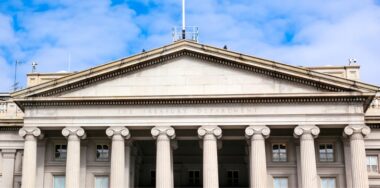Binance says its admissions of guilt regarding its long history of noncompliance shouldn’t be used by America’s securities regulator to illustrate the digital asset exchange’s refusal to comply.
This week, Binance submitted a flurry of new briefs with the U.S. District Court for the District of Columbia, which is handling the civil complaint filed this summer by the Securities and Exchange Commission (SEC) against Binance and its founder Changpeng ‘CZ’ Zhao. Binance/CZ stand accused of offering unregistered securities to U.S. citizens and misleading investors for fun and profit.
On December 8, the SEC filed a brief asking the court to allow the SEC to introduce evidence stemming from the record $4.3 billion settlement reached last month between Binance/CZ and the U.S. Department of Justice to resolve charges of violating anti-money laundering laws and helping others evade economic sanctions. The SEC argues that the (a) facts presented and (b) admissions of guilt made within that settlement are a nice complement to the SEC’s case against Binance.
Binance’s defense against the SEC complaint is based in part on the exchange’s claim that it never received “fair notice” from the SEC that it was violating America’s securities laws. The SEC’s new brief argues that Binance was “aware of and deliberately took steps to subvert U.S. law.” The SEC further argues that Binance can no longer claim that the SEC’s complaint involves “non-actionable extraterritorial conduct” because Binance/CZ admitted having “deliberately conspired to not comply with U.S. law” to boost the exchange’s profits.
On December 12, Binance/CZ filed their response to the SEC’s brief, which Binance’s attorneys claim is “procedurally improper and impermissible” and “fails to demonstrate the relevance” of Binance’s settlement with the Department of Justice (DOJ) and several other federal agencies (but not the SEC). Binance/CZ thinks it’s unfair that the SEC is trying to “introduce new factual information and arguments” that make Binance/CZ look really, really guilty.
Binance/CZ and the CZ-controlled entities that run the U.S.-licensed Binance.US exchange also filed new motions seeking to dismiss the SEC’s complaint outright. These motions all advance previously stated arguments that none of the tokens/products offered to U.S. customers qualify as unregistered securities because, uh, if they were, that would be really bad for Binance/CZ.
Binance/CZ also accuses the SEC of overstepping its mandate, claiming that Congress hasn’t authorized the SEC to target digital assets. In fairness, Congress hasn’t passed any new digital asset rules because (a) Congress can’t pass anything in its current partisan stalemate, and (b) digital assets are already covered by existing laws governing other financial instruments.
Popping the hood
Last weekend, former SEC director of enforcement John Reed Stark revealed that the DOJ had disclosed more details on the strict new regulatory oversight Binance will face as a condition of its settlement. Stark likened the extent of this oversight to Binance and its customers subjecting themselves to “a 24/7, 365-days-a-year financial colonoscopy.”
Among the more uncomfortable aspects of this anal imposition is the appointment of an independent compliance monitor, who will have free rein to examine Binance transactions for a three-year period to ensure the exchange is honoring the terms of its settlement. While Binance will foot the costs of this monitor, the parties will enjoy no “attorney-client relationship” that would allow Binance to keep certain aspects of its operations under wraps.
This monitor will be granted unfettered access to Binance documents, current and former staff/shareholders, as well as “direct observation of selected systems and procedures … including those related to know-your-customer, customer due diligence, U.S. sanctions screening, real-time transaction monitoring, law enforcement notifications, internal accounting controls, record-keeping, and internal audit procedures.” (That sound you just heard was Binance’s sphincter involuntarily snapping shut.)
Once the monitor is in place, he/she/they will have 60 days in which to file their first ‘written work plan.’ After receipt of this plan, Binance will have 30 days to provide comments. The monitor’s first official review will start within 120 days of their engagement. The first report is due within 150 days following the start of the review.
Once Binance is given a copy of this report, it will have 150 days to “adopt and implement all recommendations in the report.” If it has any objections to these recommendations, Binance can propose other means by which the monitor can achieve their objectives, but the DOJ will ultimately make that call.
The monitor’s second review will get underway no later than 180 days after the first report is filed, with a second report to be filed within 120 days of the start of review #2. A third review will start no later than 150 days after report #2 is filed.
Should the monitor find evidence of ‘potential misconduct,’ the monitor will immediately notify Binance’s chief compliance officer (a role currently held by ex-Gemini exec Noah Perlman, who also played a role in the short & ill-fated life of Moonstone Bank). However, the monitor can skip this step and directly inform the DOJ should they conclude that Binance’s shortcomings are particularly egregious.
Regardless, the monitor is to immediately alert the DOJ if Binance’s actions rise to the level of ‘actual misconduct’ that “may constitute a criminal or regulatory violation.” The monitor isn’t required to first alert Binance if the misconduct involves senior management, an obstruction of justice, or poses a risk of harm to individuals or national security.
The Treasury Department’s Financial Crimes Enforcement Network (FinCEN) has a similar deal to monitor Binance’s activities, except it spans a five-year term. To say the net impact on Binance’s operations—particularly the vast hordes of customers who were onboarded with little to no KYC—will be significant is a serious understatement.
This is fine
Binance would have you believe that rumors of its regulation-inflicted death are greatly exaggerated. The company issued a blog post on Tuesday insisting that it has “taken full responsibility for its past conduct, made significant efforts to improve its compliance initiatives, and built a stronger, safer platform.”
Binance offered a quote it identified as coming from FinCEN’s consent order about how Binance “remodeled its compliance program governance and organization structure, including by hiring new compliance leadership with professional compliance experience in the financial sector and law enforcement.”
However, if this blog is supposed to exemplify Binance’s newfound attention to detail, someone should let them know that this phrase doesn’t appear anywhere in FinCEN’s consent order. It actually appears in the enforcement release issued by the Treasury Department’s Office of Foreign Assets Control (OFAC). Hopefully, Binance will approach its KYC/AML responsibilities with more scholarly rigor.
There’s no question that Binance’s forced march to compliance has already taken a toll on its operations. CCData’s most recent report on centralized exchange spot and derivatives trading volume shows Binance’s market share currently sitting at 42.7%, a significant climbdown from its 62.6% share in February. And while Binance remains the dominant exchange by a healthy margin, its share has now fallen for 10 consecutive months.
Given that Binance will soon have to operate under the watchful gaze of not one but two U.S.-approved transaction monitors, reversing that downward trend will prove a labor worthy of Hercules.
No, really, this is fine
The day after Binance’s compliance-trumpeting blog post, the company’s new CEO, Richard Teng, tweeted some DeFiLlama data showing “strong inflows” of capital into Binance. This helped offset the significant outflows Binance endured in the immediate aftermath of its DOJ settlement.
There are a couple of caveats here, including the fact that the inexplicable surge in the fiat value of many prominent tokens over the past several weeks means it now takes fewer of those inflowing assets to create an impressive collective total.
There are also some iffy ‘please deposit’ offers that Binance has been making for its staking programs. These include offering up to 19% APR for locking up certain tokens for periods of up to 120 days. Honestly, it’s like Celsius never happened.
Meanwhile, market-wide spot trading volume in the current quarter is well below what it was in Q1, a period in which the impact of FTX’s downfall was still reverberating through the sector, and retail traders were licking their badly burnt fingers. The recent surge in token values also appears to have defibrillated the era in which meme coins could moon based on pure FOMO (and/or dogs wearing hats).
Before anyone declares that Binance is back, baybee, maybe think hard about whether this signals a return to the ‘good ole days’ or the dark ages.
Follow CoinGeek’s Crypto Crime Cartel series, which delves into the stream of groups—from BitMEX to Binance, Bitcoin.com, Blockstream, ShapeShift, Coinbase, Ripple, Ethereum,
FTX and Tether—who have co-opted the digital asset revolution and turned the industry into a minefield for naïve (and even experienced) players in the market.
New to blockchain? Check out CoinGeek’s Blockchain for Beginners section, the ultimate resource guide to learn more about blockchain technology.








